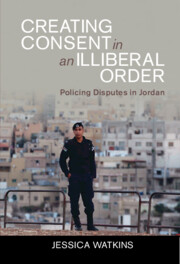116 results
A multiscalar approach to survey of military and trade architecture in Jordan: the case of Khirbet al-Khalde
-
- Journal:
- Antiquity , First View
- Published online by Cambridge University Press:
- 31 May 2024, pp. 1-7
-
- Article
-
- You have access
- Open access
- HTML
- Export citation
Jordanian Nurses’ Perceptions of Disaster Preparedness and Core Competencies
-
- Journal:
- Disaster Medicine and Public Health Preparedness / Volume 18 / 2024
- Published online by Cambridge University Press:
- 24 April 2024, e96
-
- Article
-
- You have access
- Open access
- HTML
- Export citation
Nurturing families: A feasibility randomised controlled trial of a whole-family intervention with vulnerable families in Jordan
-
- Journal:
- Cambridge Prisms: Global Mental Health / Volume 11 / 2024
- Published online by Cambridge University Press:
- 11 April 2024, e51
-
- Article
-
- You have access
- Open access
- HTML
- Export citation
The History of the Development of Clay Mineralogy
-
- Journal:
- Clays and Clay Minerals / Volume 36 / Issue 2 / April 1988
- Published online by Cambridge University Press:
- 02 April 2024, pp. 97-101
-
- Article
- Export citation
The Rule-of-Law as a Problem Space: Wāsṭa and the Paradox of Justice in Jordan
-
- Journal:
- Comparative Studies in Society and History / Volume 66 / Issue 1 / January 2024
- Published online by Cambridge University Press:
- 24 October 2023, pp. 131-154
-
- Article
-
- You have access
- Open access
- HTML
- Export citation
Deynekoite, Ca9□Fe3+(PO4)7 – a new mineral of the merrillite group from phosphide-bearing contact facies of paralava, Hatrurim Complex, Daba-Siwaqa, Jordan
-
- Journal:
- Mineralogical Magazine / Volume 87 / Issue 6 / December 2023
- Published online by Cambridge University Press:
- 11 September 2023, pp. 943-954
-
- Article
- Export citation
5 - Crony Capitalism in International Comparison
-
- Book:
- Making Democracy Safe for Busines
- Published online:
- 22 June 2023
- Print publication:
- 06 July 2023, pp 148-168
-
- Chapter
- Export citation
Umm Huwaiwitat: a Neolithic site near Petra, Jordan
-
- Article
-
- You have access
- Open access
- HTML
- Export citation
12 - The Monastic Landscape of Mount Nebo: An Economic Pattern in the Province of Arabia
- from III. - Monastic Encounters: Travel, Pilgrimage, and Donations
-
-
- Book:
- Monastic Economies in Late Antique Egypt and Palestine
- Published online:
- 14 April 2023
- Print publication:
- 20 April 2023, pp 334-358
-
- Chapter
- Export citation
COVID-19 and non-communicable diseases in complex vulnerable populations: evidence from Jordan
-
- Journal:
- Primary Health Care Research & Development / Volume 24 / 2023
- Published online by Cambridge University Press:
- 20 January 2023, e8
-
- Article
-
- You have access
- Open access
- HTML
- Export citation
First records of two large pelagic fishes in the Red Sea: wahoo (Acanthocybium solandri) and striped marlin (Kajikia audax)
-
- Journal:
- Journal of the Marine Biological Association of the United Kingdom / Volume 102 / Issue 7 / November 2022
- Published online by Cambridge University Press:
- 01 November 2022, pp. 505-508
-
- Article
-
- You have access
- Open access
- HTML
- Export citation
Chapter 5 - Psychological Assessment in the Levant
-
-
- Book:
- International Histories of Psychological Assessment
- Published online:
- 28 July 2022
- Print publication:
- 11 August 2022, pp 82-100
-
- Chapter
- Export citation
Preventive and Avoidant Behaviors Followed by Jordanians During COVID-19 Pandemic
-
- Journal:
- Disaster Medicine and Public Health Preparedness / Volume 17 / 2023
- Published online by Cambridge University Press:
- 27 July 2022, e222
-
- Article
- Export citation
1 - Introduction
-
- Book:
- Creating Consent in an Illiberal Order
- Published online:
- 02 June 2022
- Print publication:
- 09 June 2022, pp 1-27
-
- Chapter
- Export citation
Misconceptions Related to COVID 19 Vaccines Among the Jordanian Population: Myth and Public Health
-
- Journal:
- Disaster Medicine and Public Health Preparedness / Volume 17 / 2023
- Published online by Cambridge University Press:
- 08 June 2022, e207
-
- Article
- Export citation

Creating Consent in an Illiberal Order
- Policing Disputes in Jordan
-
- Published online:
- 02 June 2022
- Print publication:
- 09 June 2022
5 - The Political Economy
-
- Book:
- The Mamluk Sultanate
- Published online:
- 05 May 2022
- Print publication:
- 26 May 2022, pp 154-202
-
- Chapter
- Export citation
7 - The Rural Environment, Gendered Issues, Minority Communities, Sufi Practice
-
- Book:
- The Mamluk Sultanate
- Published online:
- 05 May 2022
- Print publication:
- 26 May 2022, pp 243-278
-
- Chapter
- Export citation
Between Church and State: The Challenges of Reforming the Church Courts and Family Law in the Greek Orthodox Patriarchate of Jerusalem
-
- Journal:
- International Journal of Middle East Studies / Volume 54 / Issue 2 / May 2022
- Published online by Cambridge University Press:
- 16 May 2022, pp. 282-301
- Print publication:
- May 2022
-
- Article
-
- You have access
- Open access
- HTML
- Export citation
28 - Implications for Future Negotiations
-
- Book:
- International Law and the Arab-Israeli Conflict
- Published online:
- 21 April 2022
- Print publication:
- 28 April 2022, pp 421-426
-
- Chapter
- Export citation



